Are you a Quiet Speculation member?
If not, now is a perfect time to join up! Our powerful tools, breaking-news analysis, and exclusive Discord channel will make sure you stay up to date and ahead of the curve.
Ever since joining Twitter, I’ve had a goal of “going viral” in some manner (preferably not in a negative context). Unfortunately, pigeonholing myself into a subculture within a subculture known as “Magic finance” and/or “Old School Magic” significantly limits my reach. I suspect this is why I’ve capped at around 3,500 followers for many years now.
Given my limited circle, I was thrilled with the reach a tweet of mine had last week—as of this morning, the total number of impressions is flirting with 100,000!
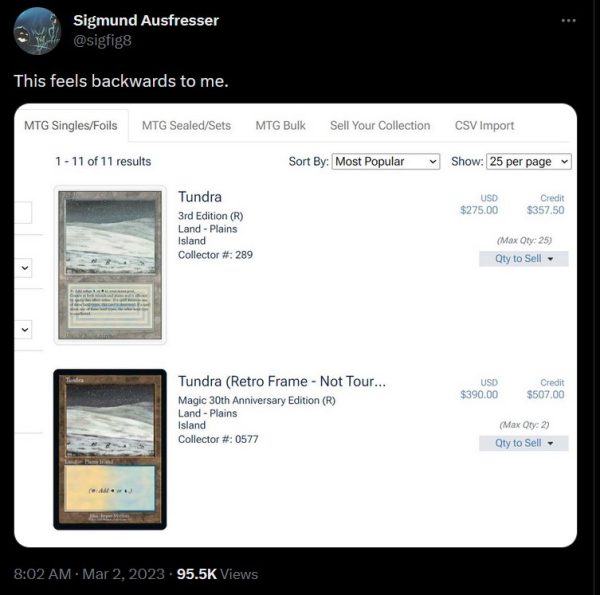
Simple, elegant, and easy to interpret—these seem to be characteristics of an influential tweet. I was delighted to see responses from across the board! The coolest part was seeing multiple quoted retweets in different languages. I went global!
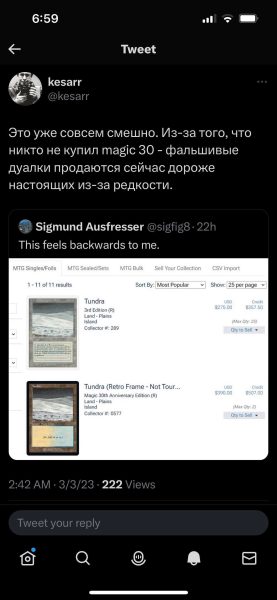
Clearly, the topic of this tweet, a comparison of Revised and retro-framed Magic 30 (M30) Dual Lands is in order. I’ll investigate the data and explore the overall sentiment distribution of the community.
Just the Facts, Ma’am
I’ll begin with the data, focusing on Card Kingdom’s buylist prices (as pictured in my tweet above). Here is a comparison of the data:
Card Name: Revised NM Buy Price / M30 Retro Frame NM Buy Price / M30 New Frame NM Buy Price
- Volcanic Island: $535 / $520 / $295
- Underground Sea: $440 / $520 / $295
- Tropical Island: $365 / $425 / $325
- Tundra: $275 / $390 / $295
- Bayou: $260 / $325 / $260
- Badlands: $255 / $295 / $230
- Savannah: $245 / $295 / $230
- Taiga: $245 / $325 / $230
- Plateau: $175 / $325 / $215
- Scrubland: $175 / $325 / $195
Card Kingdom is paying more on retro frame Magic 30 Dual Lands as compared to their Revised counterparts with one exception: Volcanic Island.
Non-retro-frame Dual Lands from Magic 30 are cheaper than their respective retro-frame copies. When comparing these less popular copies to Revised ones, some are more expensive and some are cheaper. I count six that are cheaper than Revised, three more expensive, and one priced the same.
These numbers are subject to change as Card Kingdom does tend to update their buy and sell prices quickly on such high volume cards as Dual Lands. Hopefully, this snapshot in time gives you a feel for where pricing is even if the numbers fluctuate. Even with some noise in the data, the bottom line is clear: retro-frame Magic 30 Dual Lands are more expensive than both non-retro and Revised copies.
The Reactions
My initial impression of this comparison was one of curiosity. While I couldn’t help but pass some judgment on the data (I am human, after all), the intent of my tweet was not to incite a debate about the merits and meretriciousness of Magic 30 Dual Lands. (I’m using the second definition of “meretriciousness” here, by the way. “Tawdrily and falsely attractive, superficially significant, pretentious.”)
Because Twitter is what it is, a debate is exactly what unfolded in my feed in response to my tweet. While the tweet netted over 20 retweets and over 20 responses, I can categorize them all into three primary buckets. I will do my best to share each of these viewpoints objectively, without personal bias. Please note that the points I make across these three buckets do not necessarily reflect my own opinion.
Bucket 1: Disgust
Ever since the concept of Magic 30 was announced, many players decried the set as a cash grab on Wizards of the Coasts’ part. The opinion was that this predatory product was designed to drive up sales and create an inflated collectible for the sole purpose of pleasing shareholders.
Many members of the community are still upset about this perceived transgression, and some of the responses to my tweet reflect this frustration.

As a reminder, these cards are proxies, they’re not tournament legal, and they come from booster packs that were sold at a rate of $1,000 per four packs when they were released. That is a lot of money for four booster packs of cards that aren’t tournament legal.
Today a set of four boosters will cost you around $1200 buying from the secondary market on a platform such as TCGplayer.
Bucket 2: Justification
Another popular response to my tweet was an attempt to explain/justify the difference in price between the Revised Tundra and the retro-frame Magic 30 counterpart. Whether it was out of genuine appreciation for the proxies or merely an attempt to “put me in my place”, there was a significant representation of Magic 30 defenders.
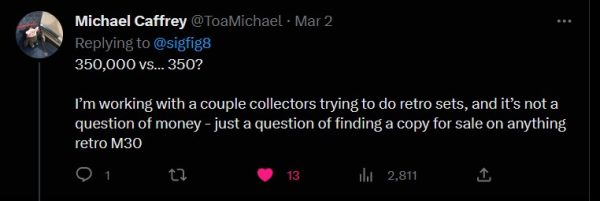
Multiple people, including popular vendors such as Tales of Adventure (above), provided a rationale for why these cards are priced the way they are relatively speaking. In short, the Magic 30 retro frame cards are scarce—Michael Caffrey estimated 350 copies of each rare—so if a handful of people are pursuing a complete set, it won’t take much to move their prices significantly.
Honestly, if I may interject my personal opinion here for a moment, I must say that if I had assurance that Wizards of the Coast would never print a product like this again, I’d advocate picking up these retro-frame cards for long-term investment. They’re extremely rare and will disappear from the market and into collections given enough time. Scarcity can drive collectible prices sky-high as long as there’s some basis for demand.
Bucket 3: Financial Outlook
The third bucket of responses is those engaging in dialogue about the price predictions of these cards.

Eric’s question above is a logical follow-up to my tweet: will Magic 30 copies drop in value or will Revised increase? In reality, there’s no rule that says they should be priced identically, and I did not intend to imply that with my original tweet. However, I think the question is a fair one. Collectors aside, if one is looking for a copy to shuffle in a deck, why not choose the less expensive option?
Will the price differential sustain because people really prefer black-bordered cards? If Dual Lands are primarily played in Commander, maybe the non-tournament legal nature of the Magic 30 copies isn’t a major factor. On the other hand, if I want to build a deck in Commander with a restricted budget, I’d be perfectly fine playing a Revised Dual Land to save $100+ over the Magic 30 alternative.
What about comparisons to Collectors’ Edition? This was another response I received, extending the financial outlook discussion to the older, square-bordered parallel.

This is another great question. Collectors’ Edition Dual Land prices have definitely dropped over the past six months, but was that in response to Magic 30, or is it just a victim of the softening secondary market? Perhaps it’s both? It’s tough to say with certainty, but I could see the non-retro-framed versions of Magic 30 Dual Lands maintaining price points near corresponding CE/IE copies in the long term.
My Personal Take
I did my best to capture each bucket above without allowing my opinion to sway my prose. Of course, as a finance columnist, I have my own thoughts on Magic 30 Dual Lands and their current pricing. My intent isn’t to pour gasoline on a dumpster fire of a debate, however, so I’ll try to keep this brief.
As a player, I have no interest in Magic 30. I’m perfectly happy playing the cheapest copies I can find (and often that is Revised). As a collector, I also have a bias toward Revised copies because that’s what I remember owning over the years. Most of you already know I’m a sucker for nostalgia.
When it comes to Magic finance and investment, I do find myself intrigued by Magic 30 cards. It has become apparent that these cards are extremely scarce—retro-frame versions, especially so. When random commons like Flight are buylisting for $3.20 (non-retro-frame) or $11 (retro-frame), my interest is piqued. I love the classic artwork on Flight just as much as the next person, but seeing the retro-frame Magic 30 copy buylisting for nearly double its Beta counterpart is eye-popping. Despite their lack of tournament legality, these retro-frame cards are rare and they’re for real.
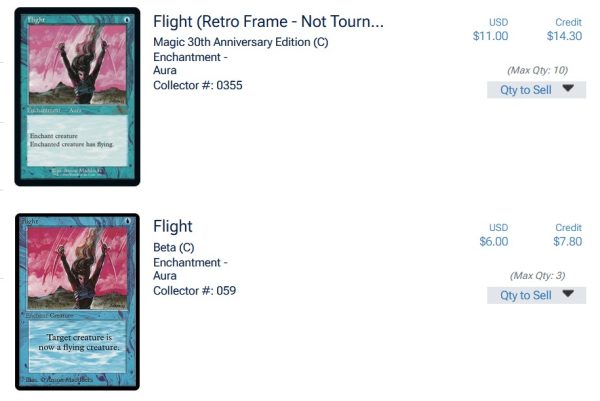
I don’t know if I’ll actively acquire any of these cards, but I may take a flyer (no pun intended) on a few nostalgic cards if I can find an attractive price point. I believe having a little diversification into retro-frame Magic 30 cards is a savvy financial play. As long as Wizards of the Coast doesn’t make another set of these, and they stop giving them away at large events like the one in Las Vegas last year, these will see a diminishing supply over time. That’s a recipe for rising prices, and I wouldn’t mind a piece of that action.
Wrapping It Up
Some people were brilliant in their prediction of Magic 30 prices at the onset. I remember when one Magic vendor, @bashmcalister, touted his decision to purchase a bunch of Magic 30 packs when they launched. Talk about a lucrative payday!
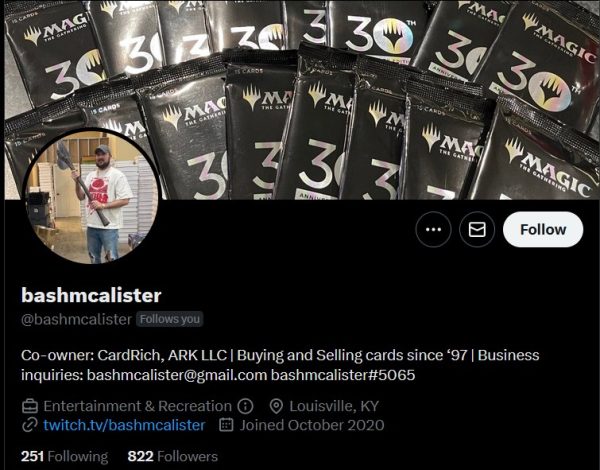
I didn’t believe, and I must give credit where credit is due. The collectible allure of this extremely rare product is driving price points I didn’t think possible. I’m not at all surprised by the price of the Power—there really was no cheap alternative for those. As for retro-frame Flight and other such commons, price points are exceeding anything I could have imagined.
This is one market I’ll pay close attention to going forward. I’ll do my best to pick up a retro-frame Magic 30 card here or there, and we’ll see where things go. Craw Wurm remains one of my favorite cards from my classical days of Magic so that one will probably top the want list.
As for Dual Lands, I think I’ll stick to the tournament-legal, more nostalgic, and less expensive Revised copies. I already have a Tropical Island and Plateau, and I just recently purchased a Tundra from a Canadian seller (fitting, right?). Regardless of their Magic 30 counterparts, I like Dual Lands for their 2023-2024 prospects.
What do you think though? Should I diversify out of Revised and into a couple of Magic 30 copies? Follow me on Twitter and weigh in with your thoughts: @sigfig8.





I’m one of those who bought the Magic 30 box set. I wasn’t intending to but after watching the prices at Card Kingdom it felt like a no brainer. Do I like it? Not really. The box is kept sealed. I’m not even curious. I love the idea of Alpha and Beta being reprinted with the modern design but the print run was insanely small. Releasing a product everybody wants but nobody can buy. That’s outrageous on so many levels.
It’s awful though. It’s obvious that the overall Magic community does not want a product like this. Yet, buying it can make financial sense. So if they get purchased that is signaling to Wizards to continue to do this which, no, very few people truly want. Magic being at the control of a few whales will make people turn to proxies much sooner but Hasbro only cares about this financial quarter, not another 30 years.